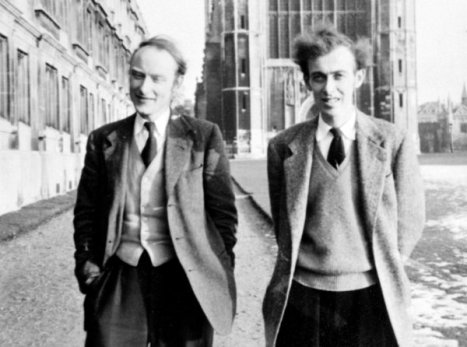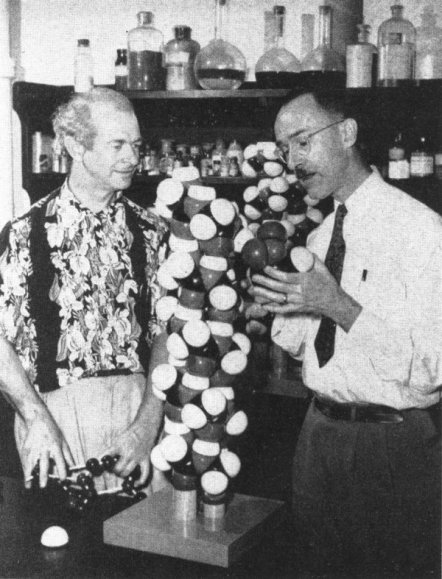
Dr. Emile Zuckerkandl, 1986.
In 1963, a year after first publishing their ideas on the study of molecules as indicators of evolutionary patterns, Emile Zuckerkandl and Linus Pauling continued to explore what they felt to be a very promising thread of inquiry.
Specifically, the two joined in arguing that the molecular clock method – as they had since termed it – might be used to derive phylogenies (or evolutionary trees) from essentially any form of molecular information. This position was further explicated in “Molecules as Documents of Evolutionary History,” an article published in Problems of Evolutionary and Industrial Biochemistry, a volume compiled in 1964 on the occasion of Soviet biochemist Alexander Oparin’s 70th birthday.
Zuckerkandl and Pauling’s most influential work on this subject was first put forth that same year, in a paper that they presented together at the symposium “Evolving Genes and Proteins,” held at the Rutgers University Institute of Microbiology. The talk, formally published a year later and titled, “Evolutionary Divergence and Convergence at the Level of Informational Macromolecules,” classified molecules that occur in living matter into three groups. Each of these groups was identified according to new terms that the pair had developed that were based on the degree to which specific information contained in an organism was reflected in different molecules. These three categories were:
1.Semantophoretic Molecules (or Semantides), which carry genetic information or a transcript of it. DNA, for example, was considered to be composed of primary semantides.
2. Episemantic Molecules, which are synthesized under control of tertiary semantides. All molecules built by enzymes were considered episemantic.
3. Asemantic Molecules, which are not produced by the organism and do not express (directly or indirectly) any of the information that the organism contains. In their discussion, Zuckerkandl and Pauling were quick to point out that certain asemantic molecules may shift form. Viruses, for example, can change form when integrated into the genome of the host; so too can vitamins when used and modified anabolically.
Semantides were considered most relevant to evolutionary history, but the term never caught on in biology, paleontology, or other allied fields relevant to the study of evolution. Nonetheless, whatever the nomenclature, the “semantides” that Zuckerkandl and Pauling wanted to investigate – DNA, RNA, and polypeptides – proved indeed to be precisely the treasure trove of information on evolutionary history that the duo had hoped would be the case.

A figure from the French translation of Zuckerkandl and Pauling’s 1964 paper.
Fundamentally, Zuckerkandl and Pauling aimed to elucidate how one might gain information about the evolutionary history of organisms through comparison of homologous polypeptide chains. In examining these substances, the researchers sought specifically to uncover the approximate point in time at which the last common ancestor between two species disappeared. In essence, it is this approach that we speak of when we use the terms “molecular clock” or “evolutionary clock.”
Zuckerkandl and Pauling argued that, by assessing the overall differences between homologous polypeptide chains and comparing individual amino acid residues at homologous molecular sites, biologists and paleontologists would be better equipped to evaluate the minimum number of mutational events that separated two chains.
With this information in hand, researchers would thus be empowered to exhume the details of evolutionary history between species, as inscribed in the base sequences of nucleic acids. This set of data, they believed, would hold even more useful information than would corresponding polypeptide chain amino acid sequences, since not all substitutions in the nucleotides would be expressed by differences in amino acid sequence.

A table from Zuckerkandl and Pauling’s 1965 Bruges paper.
As their work moved forward, Pauling and Zuckerkandl published another paper, 1965’s “Evolutionary Divergence and Convergence in Proteins.” This publication appeared in Evolving Genes and Proteins, a volume that emerged from a conference that the two had attended in Bruges, Belgium.
By this point, the duo’s idea of the molecular clock, or “chemical paleogenetics,” had elicited opposition from organismal evolutionists and taxonomists, as well as some biochemists. Now referring to their “semantides” simply as informational macromolecules, Zuckerkandl and Pauling used the 1965 meeting to argue strongly against their skeptics. Zuckerkandl chided
Certainly we cannot subscribe to the statement made at this meeting by a renowned biochemist that comparative structural studies of polypeptides can teach us nothing about evolution that we don’t already know.
Pauling likewise added that
Taxonomy tends, ideally, not toward just any type of convenient classification of living forms (in spite of a statement to the contrary made at this meeting).
Directly challenging those present who were attempting to discredit the idea of the molecular clock, the pair insisted that taxonomy tended toward a phyletic classification based on evolutionary history. Since the comparison of the structure of homologous informational macromolecules allowed for the establishment of phylogenetic relationships, the Zuckerkandl-Pauling studies of chemical paleogenetics therefore had earned a place within the study of taxonomy. This, they argued, was true both as a method of reinforcing existing phyletic classifications and also of increasing their accuracy. Specifically, the two claimed that
The evaluation of the amount of differences between two organisms as derived from sequences in structural genes or in their polypeptide translation is likely to lead to quantities different from those obtained on the basis of observations made at any other higher level of biological integration. On the one hand, some differences in the structural genes will not be reflected elsewhere in the organism, and on the other hand some difference noted by the organismal biologist may not be reflected in structural genes.
Indeed, it was these early observations, coupled with additional work conducted by those scientists who took their ideas seriously, that allowed for the development of a successful measure of rates of evolutionary change over time. Without these data, modern paleontologists, physical anthropologists, and geneticists would not be able to accurately determine evolutionary histories. Today, this technique has been systematized and specialized in the field of bioinformatics, which is now foundational to many studies in both biology and medicine.
The taxonomic purpose of the molecular clock, however, was only a byproduct of Zuckerkandl and Pauling’s main ambitions in studying paleogenetics: to better understand the modes of macromolecular transformations retained by evolution; to elucidate the types of changes discernible in information content; and – most importantly for Pauling – to identify the consequences of these changes for a given organism.

Linus Pauling, 1992.
Despite its considerable potential, the work of Zuckerkandl and Pauling, though conducted at such a critical juncture in a nascent field, was largely forgotten as recently as the early 1990s. In fact, in Allan Wilson and Rebecca Cann’s 1992 article, “The Recent African Genesis of Humans,” it was implied that the concept of the molecular or evolutionary clock was first developed and employed by a Berkeley anthropologist, Vincent Sarich. Sarich had collaborated with Wilson in 1967 to estimate the divergence between humans and apes as occurring between four to five millions years ago.
Pauling was still alive in 1992, and seeing this article he duly wrote to the editor of its publisher, Scientific American, pointing out that that, in fact, he and Zuckerkandl had, in 1962, issued their own estimate of the disappearance of the last common ancestor of gorilla and man. Zuckerkandl and Pauling’s calculations had yielded a divergence at about 7.6 million years before present, which Pauling pointed out was much closer than Sarich’s figure to the more recent estimates of divergence determined by Sibley and Ahlquist in 1984 and 1987. Notably, Pauling and Zuckerkandl’s estimate continues to remain closer to more contemporary notions of 8 to 10 million years.
Today, Emile Zuckerkandl and Linus Pauling are remembered as having first championed the notion of the molecular clock, even if many of the details now deemed as fundamental still needed to be ironed out by an array of scientists who followed. Regardless, as in so many other areas of science, Pauling proved once more to be on the ground floor of a new discipline. This was an academic venture that continued also to serve the younger Zuckerkandl well, as he continued on through a prolific career in science that concluded with his passing in 2013.
Filed under: Colleagues of Pauling, DNA, Hemoglobin & Sickle Cell Anemia | Tagged: Emile Zuckerkandl, evolutionary molecular clock, Linus Pauling | Leave a comment »

































